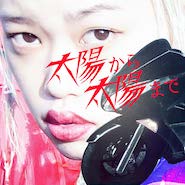French fashion label Kenzo is bringing its pre-fall 2016 collection to life through a modernized Japanese folk tale.
“Sun to Sun” reimagines the story of Momotarō, a boy born in a peach and raised by an elderly couple who goes on to become a hero with help from animal friends, shifting the narrative with a female protagonist and her posse of motorcyclists. Kenzo’s pre-fall collection was inspired by Japan, making this campaign film a fitting approach to market this season’s fashions.
“Kenzo’s video is an extension of their collection, which plays on the androgyny of the pieces,” said Romey Louangvilay, chief curator and director of digital marketing at Curate Directive, New York. “The collection plays around with traditional female symbols like flowers while having structure to them, and the video does the same thing.
“In the video, Momotaro grows ambiguous. Through various visuals, Momoko is soft and hard, good and bad, dreamy and forceful,” he said. “She’s neither one or the other, which is a reflection of how the Kenzo collection is.
“They did a good job at bringing that collection to life in a video format that plays an homage to Japanese folklore.”
Mr. Louangvilay is not affiliated with Kenzo, but agreed to comment as an industry expert.
Kenzo was unable to comment directly.
Ride along
Sun to Sun was written and directed by Partel Oliva and shot in Tokyo, the Kamajura coast and suburban Fujisawa.
In the opening scene, a lone girl is shown briefly on the beach before the film cuts to a suburban neighborhood, where a grandmother is telling the story of Momoko to a young woman who sits at her feet.
Her story features an elderly woman who discovers a giant peach while washing laundry in a river, which reveals a beautiful girl when opened. She and her husband name the girl Momoko.
As she talks, the film juxtaposes the saccharine tale with footage of a young woman swinging a baseball bat aggressively, the first in a series of ambiguous identities of Momoko throughout the film.
The next scene shows the idea of Momoko in a girl gang sporting dramatic black face paint, an homage to a practice of medieval Japanese women inspired by moths. As they speed through the city on bikes, the two black dots above their eyes make them appear both playful and fierce.
In the original lore dating from the 1700s, Momotarō decides to leave home to fight demonic villains on another island. On his way, he meets and befriends a dog, monkey and pheasant, all of whom help him on his quest.
Mr. Oliva’s adaptation depicts the members of Momoko’s clique as the animals in the original. Each bike pairs a Harajuku girl, cast with help from magazine Fruits, with a stuntwoman, again blending the cute and intimidating.
At one point, the live action film shifts to animation by Sanghon Kim, showing the women speeding through the city with flames trailing them to a soundtrack by music collective Geinoh Yamashirogumi.
While the characters in Sun to Sun wear Kenzo fashions, the film serves first as a piece of entertainment. Once consumers’ interest is piqued, the brand gives options on its Web site to buy the collection.
“The video primarily would be categorizes as entertainment,” Mr. Louangvilay said. “While the video is inspired by Japanese folklore and the brand, itself, is rooted in Japanese and Asian influencers, the video doesn’t exude an overtly promotional tone that other brands have.
“If you didn’t know that a brand made the video, you would think it was a modernized storytelling of the Japanese folklore.”
Film library
Kenzo’s campaign videos are frequently cinematic, the result of a collaboration between the brand and film directors.
The label shared homemade cake among the residents of California’s Slab City for its spring/summer 2016 collection film.
Directed by Sean Baker, “Snowbird” was filmed entirely with an iPhone and traces the journey of Theo, played by model Abbey Lee, as she traverses through the “debris-scattered [Sonoran] desert community” of Slab City, CA, known for its eccentricity and off-the-grid living. While other fashion houses are moving toward more abstract campaign films, Kenzo’s Snowbird focuses on the narrative and “eschews the glitz and glamour of fashion” (see story).
Kenzo previously looked back on 1990s teen culture for its fall/winter 2015 campaign that centered on a commissioned short film from director Gregg Araki.
“Here Now” visits a “teenage wasteland” in southern California filled with angst, romance and rebellion, using Kenzo’s collection as costumes that help to differentiate the different characters. Kenzo wanted this campaign to go beyond clothing advertising, therefore incorporating apparel as a narrative device enables the commercial aspect of the film to be more subdued (see story).
“Kenzo has always designed with the goal of being different,” Mr. Louangvilay said. “While brands traditionally have videos in short form to show the product more prominently along with storytelling, Kenzo takes the approach of telling a really good story.
“This approach works for this brand,” he said. “Kenzo isn’t like other brands and they shouldn’t be, which is why they’ve been successful at gaining a mass following. The storytelling brings the brand’s values more to life.”
from Apparel and accessories – Luxury Daily https://www.luxurydaily.com/kenzo-hits-japanese-streets-for-girl-centric-folk-tale-retelling/
via Your #1 Source to Finding Luxury & Designer Goods, Handbags & Clothes at or Below Wholesale: Click Here.



No comments:
Post a Comment